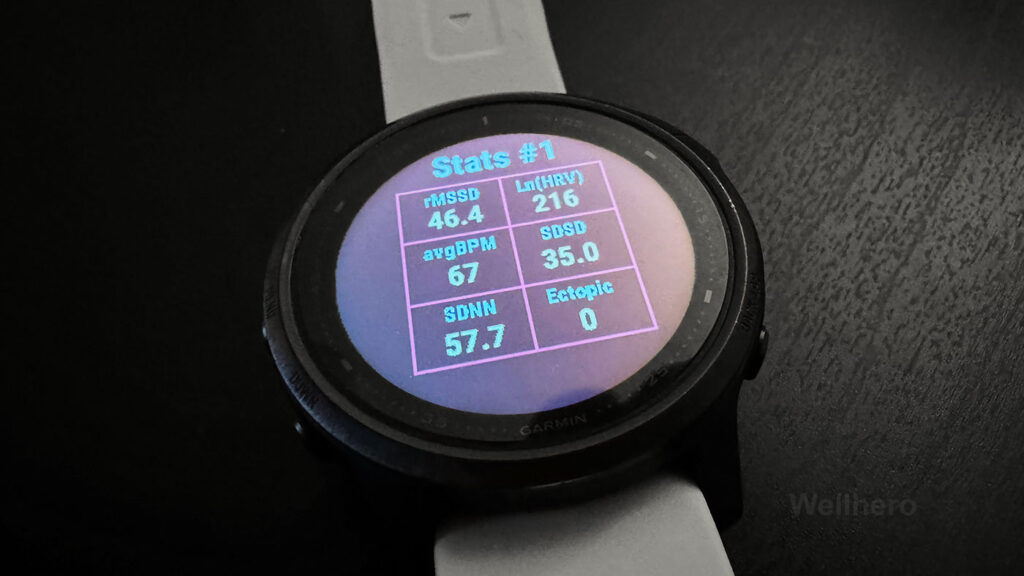This is an article in the writing stage
Ultimate guide to Heart Rate Variability (HRV)
What’s the Point of HRV Anyway?
Heart Rate Variability (HRV) – is the difference between the beats of your heart. No matter what your heart rate is, the intervals between beats will always differ by a fraction of a second.
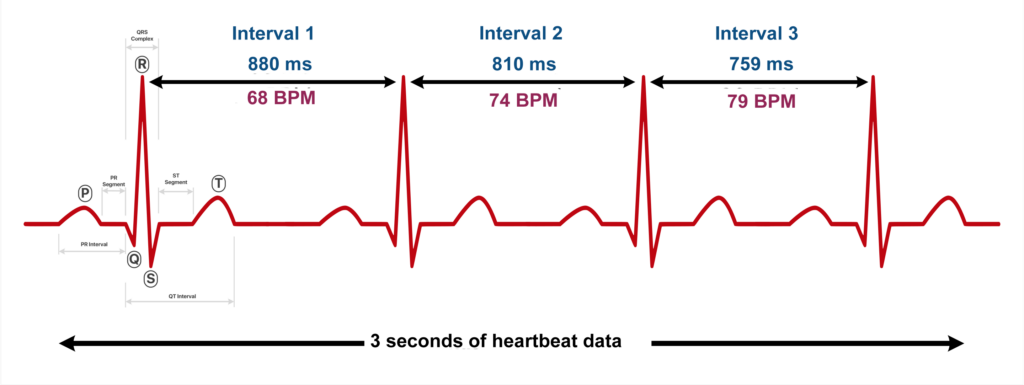
Now you know that a person’s heart rate is the number of beats at a certain time. Although measuring the heart rate can give an idea of a person’s condition (conventionally, if a person has a heart rate of 60 beats per minute, they are most likely at rest; and at a heart rate of 180 beats per minute, we can assume a strong cardio load), this information will be very generalized. This is because we have considered only the average number of beats, ignoring the intervals between them.
However, by knowing the information about each interval (further on the site and in the our mobile application, we will refer to them as RR or NN intervals), you can understand a lot about the state of a person’s health, their nervous system, whether they take certain medications, and whether they are in a state of stress or rest.
Who came up with all this HRV things?
The first mention was in 1733[1], at which time there were the first observations that pulse changes were related to respiration.
Serious research began in the 1960s when astronautics confronted the challenge of monitoring the condition of astronauts. At that time, the technical capabilities did not permit the transmission of a large amount of data to the ground. Professor Baevsky proposed using HRV to assess stress.
Most of papers we use to calculate and provide information is written in the 1990s and 2000s.
How can I measure Heart Rate Variability?
You need a reliable device measuring intervals between heart beats.
ECG
The most reliable way is to do an electrocardiogram (ECG).
Special medical equipment records the heart 250 times per second, which makes it possible to find out the time between beats as accurately as possible.
If you need to determine HRV for any medical purpose, such as obtaining and prescribing treatment, this should be your first and only option, please consult a doctor. This is important.
What if measurements are needed for sports, fitness and just maintaining a healthy lifestyle?
Bluetooth heart rate monitor (HRM)
One of the most reliable ways is to use a Bluetooth heart rate monitor. If you like to watch races, you’ve probably seen the black straps on the chests of cyclists or runners – these are just such heart rate monitors.

If you work out, buying such a sensor for $50-100 would be a good investment, but if you plan to measure heart rate and HRV only at rest, there are more affordable options.
Apple Watch
If you launch the Mindfulness app on your watch and select the Breathe program, the watch saves the intervals between measurements.
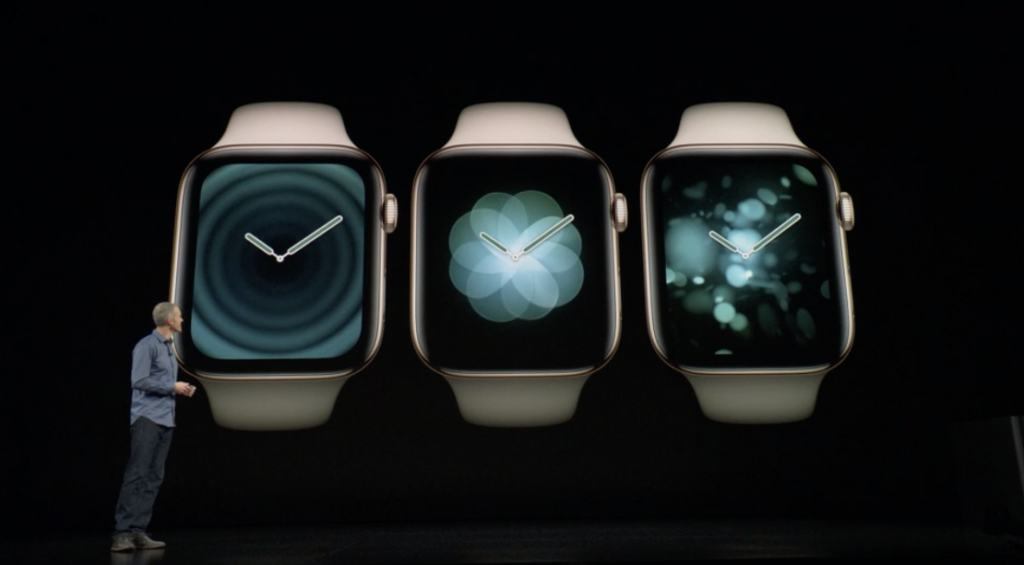
The data will be reasonably accurate [2] if you select a measurement interval of 2-3 minutes.
Camera in your smartphone
How does your smart watch measure your heart rate? There are one or 2 green LEDs on the back (green light is best absorbed by hemoglobin) and a light detector, when the heart pushes blood into the vessels, their light receptivity changes and by the amount of light absorbed the watch understands this.
But after all, we have all the same in our phone – a flashlight that emits light and a camera that can register changes in this light, all that is left is to put your finger on it 🙂
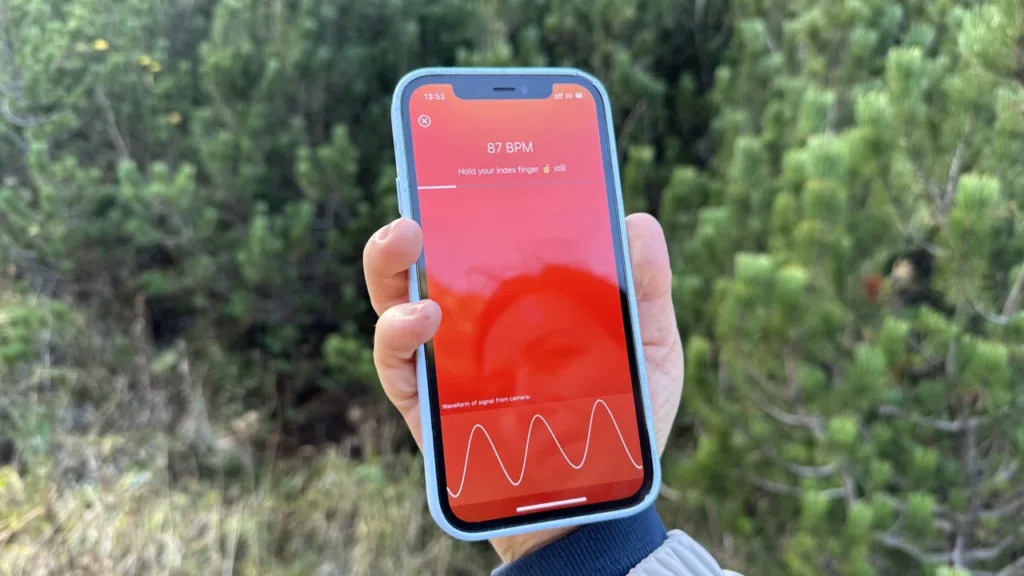
The lake, mountains and forest are the perfect place to check your stress and energy levels after a long hike.
Let’s summarise
ECG:
✅ The best accuracy;
✅ The only option for medical purpose;
🤷♀️ Not portable;
🤷♀️ The study requires a doctor;
Bluetooth heart rate tracker
✅ High accuracy;
✅ Can be used for workouts, as smart watches that measure heart rate on the wrist are not as accurate due to sweat and shaking;
🤷♀️ You have to buy another device ($50-100 for a good one);
🤷♀️ Usability: it is necessary to put on the naked body under clothes, it is necessary to wet the contact points with water before measuring (when doing sports it is not necessary – you sweat).
Apple watch
✅ One of the most popular watches, if you already have one, it’s a good option for measurements;
🤷♀️ Usability: Apple doesn’t share HRV metre data, you need to run the Mindfulness app.
🤷♀️ The accuracy is less than a Bluetooth chest heart rate monitor, because of this we need to take slightly longer measurements so that we can eliminate bad intervals and still have a margin for calculations.
Camera on your smartphone
✅ You have it;
✅ Accuracy is good;
🤷♀️ You have to get the hang of it first. Use your finger correctly, don’t press it down too hard, keep it slightly away from the flashlight in your phone so it doesn’t get hot, avoid places with bright lights or flashes of light.
What can we learn from HRV measurements?
And so, we measured the pulse, along with it, the intervals between heartbeats, but what will this give us?
For a better understanding of HRV analysis, it is necessary to grasp the principles of the nervous system, which comprises the sympathetic and parasympathetic systems.
The sympathetic nervous system mobilizes the body’s resources with the “Fight, Flight, Freeze” response, while the parasympathetic system restores the body’s resources during rest and relaxation.
HRV analysis helps to comprehend which of these systems is active and in what proportion.
| SNS Sympathetic nervous system | PNS Parasympathetic nervous system | |
| Goals | Fight, Flight, Freeze | Rest and Digest |
| Hormones | Norepinephrine and Epinephrine | Acetylcholine |
| Increases | – Heart rate – Blood pressure – Respiratory rate – Pupil dilation | – Digestion |
| Decreases | – Digestion – Urine production | – Heart rate – Respiratory rate – Blood pressure – Pupil dilation |
By understanding the interplay of these systems and the changes in this interaction over time, we can comprehend the state of the body.
That’s why it’s best to measure in the morning immediately after waking up, when external factors have not yet had a chance to influence your body’s functioning.
The most crucial aspect in HRV measurements is consistency
Many applications measure HRV and compare it with widely accepted norms derived from extensive research. We follow a similar approach but limit the initial measurements to a few instances.
Once we accumulate a sufficient amount of data about you, the algorithm will understand the specific workings of your autonomic nervous system, calculating energy and stress levels tailored to you (though we will also provide comparisons with norms).
To allow the algorithm to establish your parameters, it is advisable to measure daily. Smartwatches, such as Garmin, continuously measure your HRV and use it to display the body’s energy reserves.
For more accurate measurements, it’s essential to create consistent conditions: remain still, relax, and avoid controlling your breath. Ideally, measurements should be taken at the same time each day.
What do all these numbers in Heart Rate Variability mean?
We calculate 9 different parameters[3] of your HRV. In the app, during the measurement details, you will see the value of each parameter, a comparison with norms, and an explanation of what the current figure means for the body.
Although we calculate 9 parameters, the main ones are just 2:
- RMSSD – Root Mean Square of Successive Differences
- SDNN – Standard deviation of NN intervals
When you see HRV on Apple Watch, they show you SDNN. Most fitness trackers will show you RMSSD. SDNN and RMSSD are correlated. The lower the RMSSD and SDNN, the less influence the parasympathetic nervous system has on your body’s functioning.
If you want to learn more about other metrics, we recommend reading our article explaining all popular HRV metrics.
HRV Fluctuations
While demonstrating the app to friends during the testing phase, I frequently observed a common issue: a person takes a measurement, receives data, then a couple of minutes later takes another measurement and obtains different results. This immediately prompts the question: “Are you showing completely random data in HRV?”.
The HRV metric does indeed fluctuate over time, and it can vary significantly. For instance, take a look at the results from the past night recorded by my Garmin watch, which consistently takes measurements. These readings were taken during sleep, when the body lies peacefully in bed, free from stress or any activity:
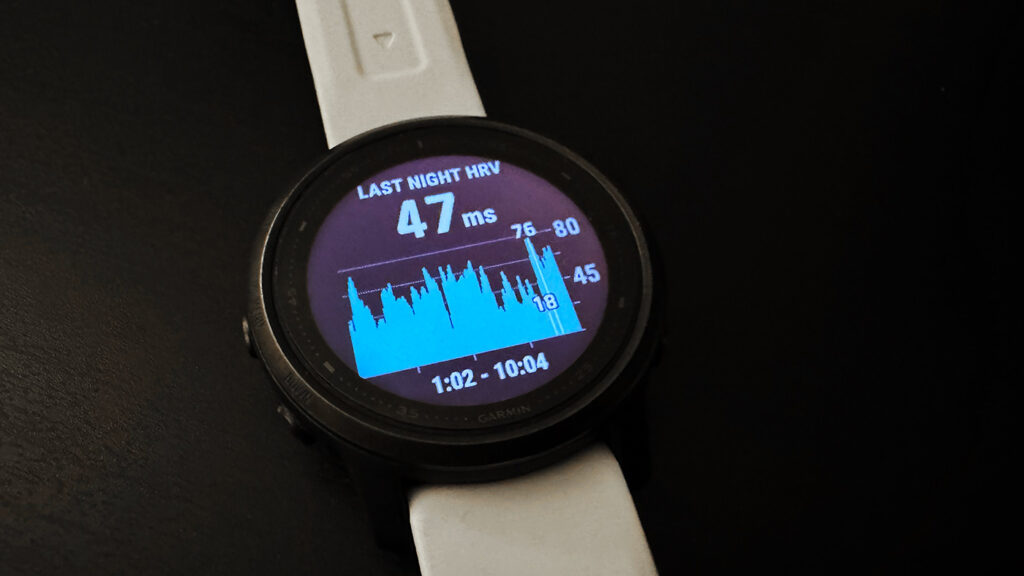
Does this mean that measuring HRV is useless? No, for several reasons:
- HRV should be compared not just with the previous value but within a range of values under similar conditions. For instance, one might observe that during the night, HRV never dropped below 18, and on average, it stays around 45, which is a satisfactory result for me.
- It’s essential to examine similar changes over the previous period. For example, here is my stress indicator for the past weeks:
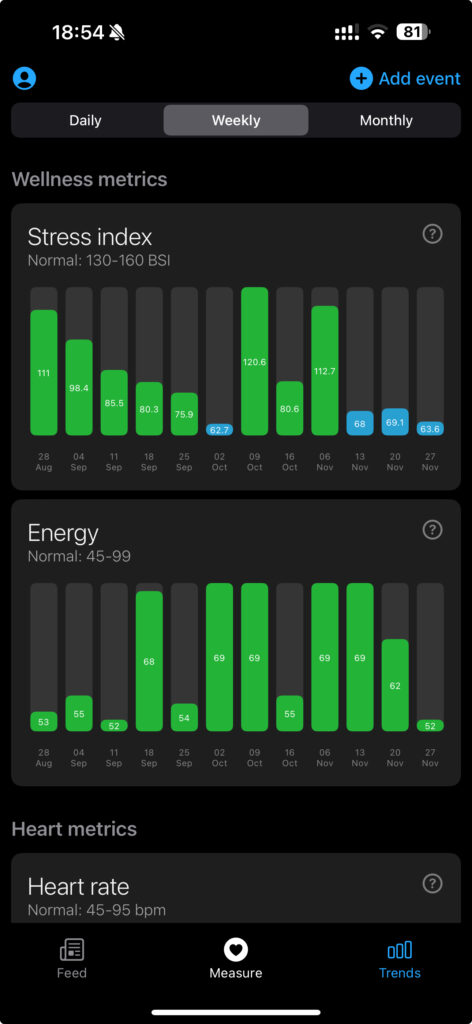
As I lead a relatively calm life, my stress levels are primarily triggered by physical activities such as running and cycling. On the graph, it’s evident that as the warm days of August faded, I reduced my cycling activities. Then, in October, I spent several days running, participating in a race (didn’t clinch a prize – I’m an amateur) and preparing for it. Over the last couple of weeks, I’ve admittedly slacked off on sports – it’s probably time to put the bike on the trainer.
References:
